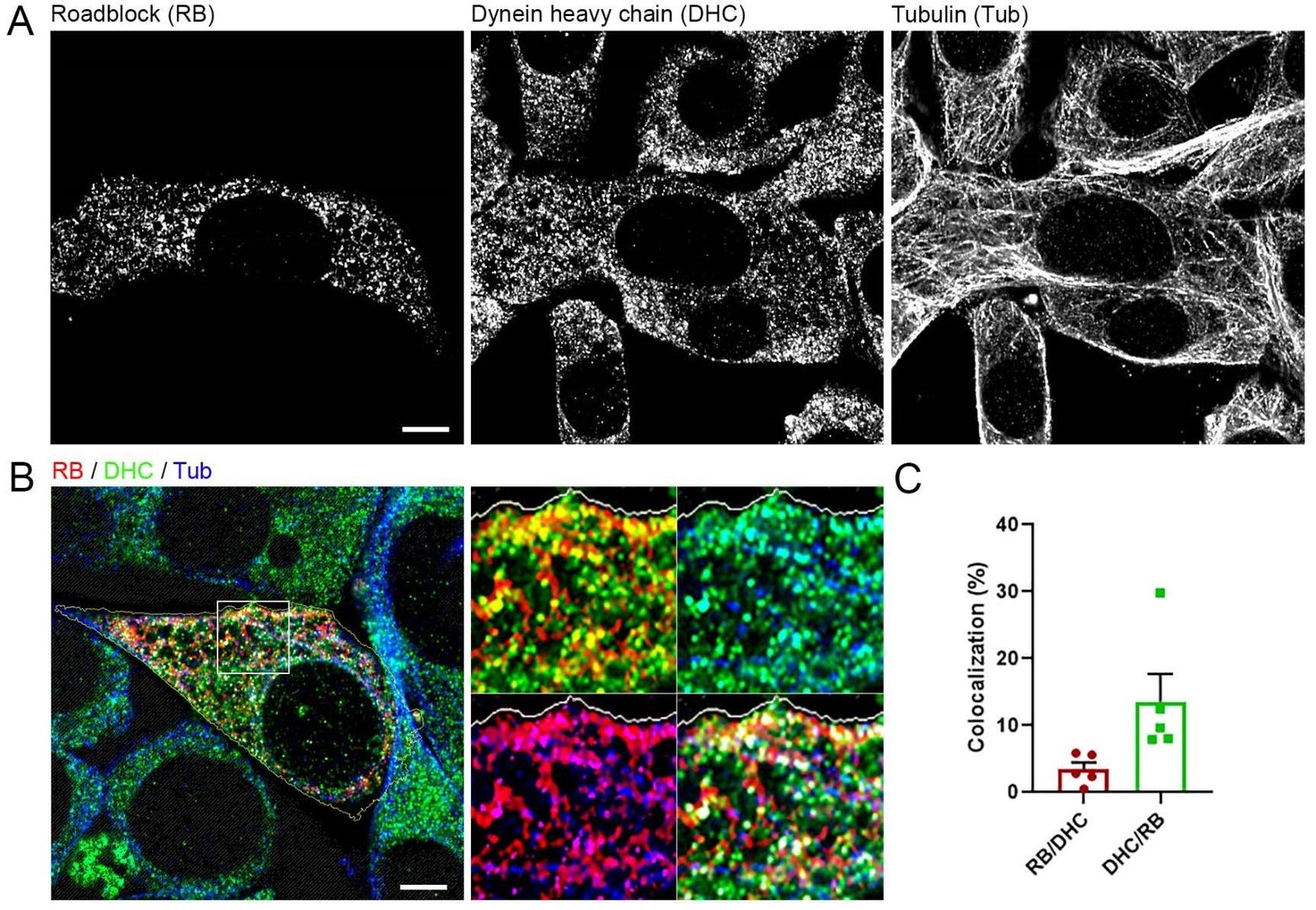FY2019 Annual Report
FY2019 Annual Report
Molecular Neuroscience Unit
Assistant Professor Marco Terenzio

(From left to right) Sara Emad El-Agamy Abdelaal, Laurent Guillaud and Marco Terenzio.
Abstract
The unit started in October 2019 and will be located in Laboratory 4, which has been under construction and will open on the 1rst of April 2020. We have finalized the planning for the space and started the outfitting of the main laboratory space and the tissue culture room. In addition, the unit has successfully recruited Dr. Laurent Guillaud as a Group Leader (January 2020) and Sara Emad El-Agamy Abdelaal as a Graduate Student (November 2019). We have also screened candidates for 3 postdoctoral positions. The 3 successful candidates are scheduled to join the laboratory between May and July 2020. In the meantime, Sara has been working on identifying interactors of Dynein Roadblock 1, a light chain of Cytoplasmic Dynein, as described below, and preparing her Ph.D. proposal. Prof. Terenzio has applied to a Kakenhi (Scientific Research C) grant, 2 international grants (Wings for Life, Chan Zuckerberg Initiative), 1 internal grant (Kicks 2020) and funding for the organization of a Workshop at OIST in 2021.
1. Staff
- Assistant Professor Marco Terenzio, Unit Leader
- Dr. Laurent Guillaud, Group Leader
- Sara Emad El-Agamy Abdelaal , Graduate Student
- Akiko Guzman, Research Unit Administrator
2. Collaborations
2.1 Local Translation and axonal dysfunction in Amyotrophic Lateral Sclerosis
- Type of collaboration: Joint research
- Researchers:
- Professor Andrea Malaspina, Queen Mary University London, UK
2.2 Design of cell-specific drugs to increase regeneration after Spinal Cord Injury
- Type of collaboration: Joint research
- Researchers:
- Professor Dan Tawfik, Weizmann Institute of Science, Israel
- Professor Simone di Giovanni, Imperial College London, UK
3. Activities and Findings
3.1 The role of Dynein-dependent retrograde axonal transport in sensory and motor neurons
Neurons are highly polarized cells with an elongated axon that extends far away from the cell body. In order to maintain neuronal homeostasis, neurons rely extensively on axonal transport of membranous organelles and other molecular complexes. Axonal transport plays a central role in the establishment of neuronal polarity, axonal growth and stabilization and synapses formation, allowing for precise spatio-temporal activation and modulation of numerous molecular cascades. Anterograde and retrograde axonal transport is supported by various molecular motors, such as kinesins and dyneins, and a complex microtubule network. Cytoplasmic dynein is the main retrograde molecular motor and is constructed around the heavy chain, which is the force-generating subunit and is composed of a motor and a tail domain. The former is responsible for motility generation while the latter acts as a platform for the association of other subunits, such as the intermediate, light-intermediate and light chains, which collectively mediate the direct and indirect binding/association of cargos. Roadblock 1 (DYNLRB1) is one of the 3 light chain families and was presumed to be an accessory subunit for specific cargoes. Recent work demonstrated that DYNLRB1 depletion in proprioceptive neurons significantly impairs retrograde axonal transport and consequently compromises neuronal survival (Terenzio et al., 2020). This observation suggests that DYNLRB1 is an essential subunit for dynein-mediated transport.
We have started to perform experiments aimed at the investigation of the molecular mechanisms behind the role of DYNLRB1 in axonal retrograde transport. We have noticed that DYNLRB1 is incorporated only in a subset of Dynein complexes (Figure 1). Therefore, we decided to characterize DYNLRB1 interactors. To this extent we created several fusion constructs of DYNLRB1 and a promiscuous biotinylating enzyme to selectively label DYNLRB1’s interactors and identify them by mass spectrometry. Sara already characterized these fusion constructs in 3T3 cells, optimized the biotinylation protocol (Figure 2A) and performed a preliminary mass spectrometry analysis (Figure 2B). We are now ready to repeat this analysis in neurons and proceed characterizing the most promising candidates in vitro and in vivo and their potential implication in the genesis of neurological disorders.

Figure 1: 3T3 cells transfected with DYNLRB1. A-B. DYNLRB1 staining is compared to tubulin and Dynein heavy chain. Only a subset of Dynein heavy chain puncta were also positive for DYNLRB1 (quantified in C), suggesting that DYNLRB1 is incorporated in a specific pool of Dynein motor complexes.

Figure 2: Optimization of proximity biotinylation. A. Cells were transfected with N and C-terminal fusion constructs between DYNLRB1 and a biotinylation enzyme. The extent of biotinylated proteins for each construct was determined by Western Blot analysis. B. Biotinylated proteins were retrieved and identified via Mass Spectrometry. A quantification of the resulting hits from this preliminary screen is shown.
4. Publications
4.1 Journals
- DYNLRB1 is essential for dynein mediated transport and neuronal survival. Terenzio M, Di Pizio A, Rishal I, Marvaldi L, Di Matteo P, Kawaguchi R, Coppola G, Schiavo G, Fisher EMC, Fainzilber M. Neurobiol Dis. 2020 Feb 20:104816. doi: 10.1016/j.nbd.2020.104816.
4.2 Books and other one-time publications
Nothing to report
4.3 Oral and Poster Presentations
- Marco Terenzio: How neurons convey information from their periphery? Faculty Lunch Seminar Series. February 13, 2020. OIST campus.
- Laurent Guillaud: ATP-dependent liquid phase transitions in synapse organization and neurodegeneration. Flash talk and poster - The 2nd Osaka University/OIST Symposium. January 21, 2020. OIST campus.
5. Intellectual Property Rights and Other Specific Achievements
Nothing to report
6. Meetings and Events
6.1 The role of topoisomerase II beta in retinal development
- Date: February 6, 2020
- Venue: OIST Campus, C700, Level C, Lab3
- Speaker: Prof. Li Cai (Rutgers, The State University of New Jersey)
7. Other
7.1 Teaching
- Title: Axonal Transport and Neurological disease & Axonal Transport: Specific focus on Dynein-mediated retrograde transport
- Curriculum: independent study
- Student: Sara Emad El-Agamy Abdelaal
- Date: January-April, 2020
- Venue: OIST campus.
- Lecturer: Marco Terenzio
- Title: Introduction to super resolution microscopy (nanoscopy) - Imaging beyond the diffraction limit
- Curriculum: Emerging technologies in life sciences course organized by Pr. Ichiro Maruyama.
- Date: March 11, 2020
- Venue: OIST campus.
- Lecturer: Laurent Guillaud



